The 2dF Galaxy Redshift Survey Fly-Through Movie
ANU (version1|version2), Swinburne (version1|version2)
|
Cosmic census shapes a trip through the Universe - 5/5/2000 Scientists today revealed a super-computer visualisation of a trip through the Universe based on actual data collected by astronomers. Professor Brian Boyle from the Anglo-Australian Observatory and Professor Matthew Bailes from Swinburne University Melbourne showed the visualisation for the first time at Science Now in Melbourne. The release coincides with a major landmark in a project to provide the most detailed three-dimensional map ever of the Universe.* A team of astronomers from Australia and the UK have now measured the distances to 100,000 galaxies, which makes their map four times larger than any previous survey. To make the information more easily accessible to the public, they have combined with computer scientists from Swinburne University to create the trip through the Universe. The astronomers have been using Australia's largest optical telescope, the 3.9-metre Anglo-Australian Telescope, and a remarkable instrument called 2dF to gather the information. The 2dF instrument allows astronomers to observe and analyse 400 objects at once, and on a long clear night, they can log the positions of more than 2000 galaxies. The Australian team leader, Dr Matthew Colless from the ANU, said, "It has taken less than two years to measure the distances for these 100,000 galaxies. Without the 2dF instrument, this project would have taken decades. We are now well on our way to reaching our target of 250,000 galaxies by the end of 2001. Our map of the Universe will then be ten times larger than any previous survey." The computer visualisation has also broken new ground. Professor Matthew Bailes from Swinburne University's Centre for Astrophysics and Supercomputing said, "Most of us are used to the Hollywood versions of travelling through the Universe, but this version is much closer to the truth. We have used the information from the survey and combined it actual photographs of galaxies, many taken using the Anglo-Australian Telescope." Professor Brian Boyle, the Director of the Anglo-Australian Observatory, said, "Astronomers will use our three-dimensional map to learn about the nature of the Universe for many years to come, but it has always been part of our aim to provide a version so that the general public can pilot their own intergalactic spaceship. Eventually we will distribute it for educational use." Although it has taken less than two years to gather
this huge amount of data, it is really the culmination of more than
seven years of effort. The 2dF instrument, one of the most complex
pieces of astronomical equipment ever built, is the key to the survey.
It uses 400 optical fibres, all of which can be positioned by an
incredibly accurate robotic arm in about one hour. The optical fibres
pipe the light from each galaxy into one of two spectrographs. The
spectrographs split the light into its component colours, and after
analysis astronomers can tell how far away a galaxy is.
* The project, the 2dF Galaxy
Redshift Survey is an international collaboration involving more than 30
scientists from 11 institutions. In Australia, the Anglo-Australian
Observatory, the Australian National University and the University of
NSW are involved. The survey aims to learn more about the structure of
the Universe, how galaxies are made and how they form into larger
structures. It will also allow astronomers to accurately measure the
total amount of matter in the Universe and get more of an idea of the
nature of 'dark matter' that makes up at least 90% of the total mass of
the Universe.
|
Still images from the movie...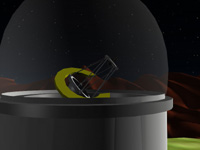 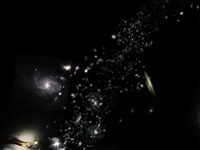 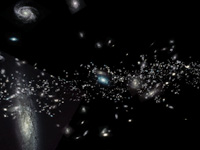 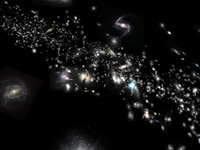 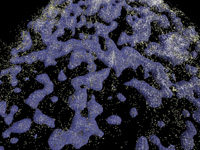 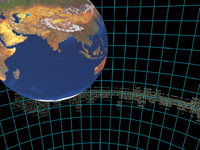 |